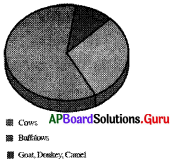Practice the AP 8th Class Biology Bits with Answers Chapter 9 Production and Management of Food From Animals on a regular basis so that you can attempt exams with utmost confidence.
AP State Syllabus 8th Class Biology Bits 9th Lesson Production and Management of Food From Animals with Answers
Choose the correct answer.
Question 1.
The common and dangerous disease in cows and buffaloes is
A) Nattala Vyadhi
B) Galikuntu
C) Viral infections
D) Bacterial diseases
Answer:
B) Galikuntu
Question 2.
The doctor who provide treatment and health care for the cattle
A) Neurologist
B) Dentist
C) Veterinary doctor
D) None
Answer:
C) Veterinary doctor
![]()
Question 3.
In Pasteurization milk is heated at the temperature
A) 62°
B) 72°
C) 82°
D) 92°
Answer:
A) 62°
Question 4.
In Odisa traditional live stock, the following buffaloes are reared
A) Murra
B) Jaferabad
C) Nagapuri
D) Ghilka
Answer:
D) Ghilka
Question 5.
Layers are reared for the production of
A) meat
B) eggs
C) skin
D) bones
Answer:
B) eggs
Question 6.
The egg prices are high in the months of
A) January
B) March
C) April
D) January to April
Answer:
D) January to April
![]()
Question 7.
The Indian traditional variety meant for fighting is
A) Aseel
B) Kadaknath
C) Chittagang
D) Bursa
Answer:
A) Aseel
Question 8.
The weight of Emu bird is nearly
A) 40 k.g.
B) 50 k.g.
C) 30 k.g.
D) 10 k.g.
Answer:
B) 50 k.g.
Question 9.
Number of queen bees in a colony is
A) 4
B) 3
C) 2
D) 1
Answer:
D) 1
Question 10.
The important fish available in our marine area is
A) Korramenu
B) Jella
C) Tuna
D) Mosu
Answer:
C) Tuna
![]()
Question 11.
Animal husbandry is a part and parcel of
A) Games
B) Agriculture
C) Swimming
D) Civilization
Answer:
B) Agriculture
Question 12.
Nattala Vyadhi (worm infection) is very common in
A) Cows
B) Buffaloes
C) Sheep and Goat
D) Prawns
Answer:
C) Sheep and Goat
Question 13.
Traditional variety of cow is
A) Jersy
B) Holstein
C) Murra
D) Nagapuri
Answer:
D) Nagapuri
Question 14.
High milk yielding foreign variety cow
A) Jersy
B) Holstein
C) Haryana
D) Both A and B
Answer:
D) Both A and B
![]()
Question 15.
What is the temperature used in Pasteurization?
A) 62°C for 30 mnts
B) 65°C for 15 mnts
C) 70°C for 30 mnts
D) 25°C for 15 mnts
Answer:
A) 62°C for 30 mnts
Question 16.
“White revolution” is related to
A) Increase in rice production
B) Increase in oil production
C) Increase in cattle production
D) Increase in milk production
Answer:
D) Increase in milk production
Question 17.
“Green revolution” is related to
A) Food grains
B) Aquaculture
C) Milk production
D) Freedom movement
Answer:
A) Food grains
Question 18.
India held this position in eggs production.
A) 4th
B) 5th
C) 6th
D) 10th
Answer:
A) 4th
![]()
Question 19.
India held this position in the production of chicken.
A) 5th
B) 4th
C) 6th
D) 8th
Answer:
A) 5th
Question 20.
White plymoth, Rhode island Red are examples for
A) Broilers
B) Layers
C) Fishes
D) Prawns
Answer:
A) Broilers
Question 21.
How many days did a hen spend to hatch its eggs?
A) 21 days
B) 25 days
C) 28 days
D) 30 days
Answer:
A) 21 days
Question 22.
Hatchability of eggs generally influenced by this temperature
A) 37°C – 38°C
B) 41°C – 42°C
C) 45°C – 46°C
D) None
Answer:
A) 37°C – 38°C
![]()
Question 23.
“Divine food” is
A) Fish
B) Prawn
C) Egg
D) Honey
Answer:
D) Honey
Question 24.
The primary function of a queen bee in a hive is
A) To lay eggs
B) To built the hive
C) Eating
D) Honey production
Answer:
A) To lay eggs
Question 25.
“Father of white revolution in India”
A) M.S. Swaminathan
B) Prof. J.K. Kuriyan
C) M.S. Viswanathan
D) Prof. Y.V. Rao
Answer:
B) Prof. J.K. Kuriyan
Question 26.
The purity of milk is calculated by
A) Galactometer
B) Ammeter
C) Monometer
D) Lactometer
Answer:
D) Lactometer
![]()
Question 27.
‘Bee Venum’ is prepared in the production of….
A) Injections
B) Tablets
C) Hormones
D) Apis tincture
Answer:
D) Apis tincture
Question 28.
India has the coast line about
A) 7500 mm
B) 7500 m
C) 6500 Km
D) 7500 kms
Answer:
D) 7500 kms
Question 29.
The major use of “bee wax” is
A) Medicinal industry
B) Textile industry
C) Furniture making
D) Shoe polish / creams making
Answer:
D) Shoe polish / creams making
Question 30.
“Flightless bird” that is reared for commercial practice
A) Ostrich
B) Emu
C) Kiwi
D) Swift
Answer:
B) Emu
![]()
Question 31.
Bones of dead cattle are used in
A) Chemical industry
B) Fertilizer industry
C) Textile industry
D) Sugar factories
Answer:
B) Fertilizer industry
Question 32.
Sea weeds are used in the production of
A) Colours
B) Medicines
C) Phycocolloids
D) Varnish
Answer:
C) Phycocolloids
Question 33.
“Operation flood” means …….
A) Increase in the production of eggs
B) Increase in the production of chicken
C) Increase in the production of milk
D) Increase in the production of fish
Answer:
C) Increase in the production of milk
Question 34.
In which month the milk production is high in our state?
A) January
B) April
C) November
D) August
Answer:
B) April
![]()
Question 35.
……….. can be produced by cattle waste.
A) Fertilizers
B) Cement
C) Biogas
D) Medicines
Answer:
C) Biogas
Question 36.
……….. million of eggs are producing per year in our country.
A) 40.06
B) 39.06
C) 41.06
D) 42.06
Answer:
C) 41.06
Question 37.
How many recognised honey bee species are there in India?
A) 3
B) 4
C) 5
D) 6
Answer:
C) 5
Question 38.
Life span of a queen bee is
A) 4 – 5 weeks
B) 5 – 6 weeks
C) 2 – 3 years
D) 7 – 8 weeks
Answer:
C) 2 – 3 years
![]()
Question 39.
Drone lives for ………. days.
A) 47
B) 37
C) 57
D) 77
Answer:
C) 57
Question 40.
Apis millifera produces …………. kgs of honey per annum.
A) 3 – 10 kgs
B) 10 – 15 kgs
C) 15 – 20 kgs
D) 25 – 30 kgs
Answer:
D) 25 – 30 kgs
Question 41.
The milk of this buffalo tastes a bit salty and kept up to 7 days without refrigeration
A) Murra
B) Jersy
C) Kangayam
D) Chilka
Answer:
D) Chilka
Question 42.
The bullock that is best suitable for drought areas
A) Chilka
B) Ongole
C) Kangayam
D) Nagapuri
Answer:
C) Kangayam
![]()
Question 43.
According to Economical and Statistical Survey of India – 2011, …………. liters of milk is produced in our state
A) 40 – 50 lakh
B) 40 – 60 lakh
C) 100 lakh
D) 20 lakh
Answer:
B) 40 – 60 lakh
Question 44.
Holstein and Jersy give ……….. liters of milk per day.
A) 15
B) 20
C) 16
D) 25
Answer:
D) 25
Question 45.
Example for sea weeds
A) Agar – agar
B) Ulva
C) Sargassum
D) All the above
Answer:
D) All the above
Question 46.
By observing the graph, name the month in which the milk production is maximum.

A) November
B) April
C) May
D) December
Answer:
A) November
![]()
Question 47.

This is the logo of
A) National Egg Co-operation Committee
B) National Egg Co-ordination Corporation
C) National Egg Co-ordination Committee
D) National Egg Coordination Commission
Answer:
C) National Egg Co-ordination Committee
Question 48.

Look at the pie diagram, we get milk from cattle. From which animals we get maximum milk production?
A) Buffaloes
B) Goats
C) Camels
D) Cows
Answer:
D) Cows
Question 49.

Can you identify this foreign variety high milk yielding species?
A) Holstein
B) Jersy
C) Jaferabad
D) Nagapuri
Answer:
A) Holstein
Question 50.

Name the great man wh0 led the “Operation flood”.
A) M.S.Swaminathan
B) Prof. J.K. Kuriyan
C) Prof. K.J. Menon
D) R.K. Menon
Answer:
B) Prof. J.K. Kuriyan
![]()
Question 51.

Can you identify this “flightless bird”?
A) Ostrich
B) Kiwi
C) Swift
D) Emu
Answer:
D) Emu
Question 52.

Name this famous local fowl variety
A) Aseel
B) Hampshire
C) Plymoth
D) Rhode island red
Answer:
A) Aseel
Question 53.

Identify the strong, healthy local bullock variety best suitable for drought areas.
A) Chilka
B) Ongole
C) Nagapuri
D) Kangayam
Answer:
D) Kangayam
Question 54.
Match the following:
Group – A — Group -B
1. Sea weeds — A) Live stock
2. Murra breed — B) Economical Value
3. Aseel (Barisa Kodi) — C) Agar-agar
4. Apis dorsata — D) Long shan
5. Oysters — E) Cock fighting
F) Foreign variety
G) Honey bee
Answer:
1) C
2) A
3) E
4) G
5) B
![]()
Question 55.
………… is an Indian traditional variety of fowl used for cockfights during festivals like Pongal.
A) Chittagang
B) White leghorn
C) Aseel
D) Bursa
Answer:
C) Aseel
Question 56.
Acqua culture : fishes :: Apiculture : …………..
A) Broiler hens
B) Prawns
C) Silk moths
D) Honeybees
Answer:
D) Honeybees
Question 57.
Apis tincture is derived from ………..
A) oil from prawns.
B) codfish liver oil.
C) toxins from honeybees.
D) oil from crabs.
Answer:
C) toxins from honeybees.
Question 58.
Kavitha formed some questions to know about the preparation of honey by honeybees. Identify the correct one.
1) How many types of honeybees participate in pollination?
2) What is the role of honeybees in pollination?
3) Do drones take part in preparation of honey?
4) Do respiration glands of honeybees prepare honey?
A) 1, 2 only
B) 2, 3 only
C) 1 only
D) 4 only
Answer:
B) 2, 3 only
![]()
Question 59.
The best suited slogan for animal husbandry is
A) Grow either traditional or hybrid varieties
B) Grow only traditional varieties
C) Grow neither traditional or hybrid varieties
D) All of these
Answer:
A) Grow either traditional or hybrid varieties
Question 60.
What is the reason for hike in price of eggs in January to April Months?
i) More eggs used for hatching
ii) Less production during summer
iii) Eggs hatched between 37° – 38°C only
A) i and ii
B) ii and iii
C) i and iii
D) ii only
Answer:
C) i and iii
Question 61.
You have collected the information about ocean weeds. Identify the ocean weed from given below names.
A) Hydrilla
B) Agar-Agar
C) Utricularia
D) Nephanthis
Answer:
B) Agar-Agar